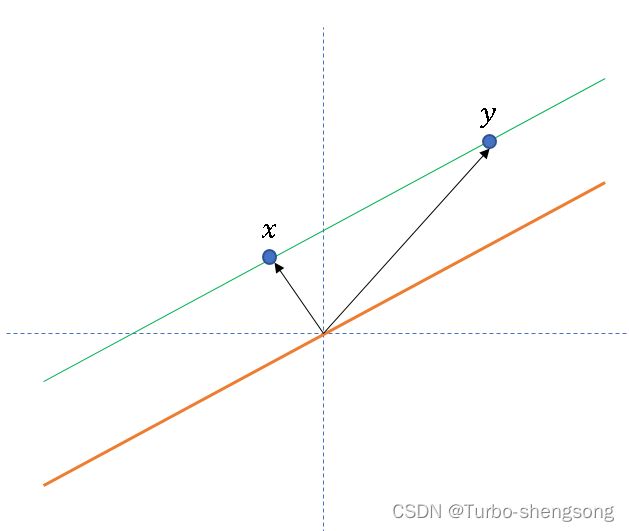商空间的理解(Quotient space)
商空间(Quotient space)
In linear algebra, the quotient space of a vector space V V V by a subspace N N N is a vector spapce obtained by “collapsing” N N N to zero. The space obtained is called a quotient space and is denoted V / N V/N V/N (read “V mod N” or “V by N”).
定义
令 V V V是数域 F \mathbb F F上的矢量空间(vector space), N N N是 V V V的子空间,即 N ⊆ V N \subseteq V N⊆V。我们定义矢量空间 V V V上的等价相关(equivalence relation ∼ \sim ∼),写为: x ∼ y x \sim y x∼y if x − y ∈ N x-y \in N x−y∈N(That is x x x is related to y y y if one can be obtained from the other by adding an element of N N N)。根据该定义,我们可以推断出:any element of N N N is related to 0 \boldsymbol 0 0。更确切地说, N N N中的所有向量都映射到零向量的等价类(equivalent class)中。
The equivalence class (or in this case, the coset) of x x x is often denoted:
[ x ] = x + N [x] = x + N [x]=x+N
具体的形式:
[ x ] = { x + n : n ∈ N } [x] = \{x+n: n \in N\} [x]={x+n:n∈N}
The quotient space V / N V/N V/N is then defined as V / ∼ V/ \sim V/∼, the set of all equivalence classes induced by ∼ \sim ∼ on V V V.
Scalar multiplication and addition are defined on the equivalence classes by:
α [ x ] = [ α x ] ∀ α ∈ F [ x ] + [ y ] = [ x + y ] \begin{aligned} \alpha [x] &= [\alpha x] \ \ \forall \alpha \in \mathbb F \\ [x] + [y] &= [x + y] \end{aligned} α[x][x]+[y]=[αx] ∀α∈F=[x+y]
证明:
(1)齐次性
α [ x ] ⇔ α [ x ] = { α ( x + n ) : n ∈ N } ⇔ { α x + n : n ∈ N } ⇔ [ α x ] \alpha [x] \Leftrightarrow \alpha[x] = \{\alpha(x+n): n \in N\} \Leftrightarrow \{\alpha x+n: n \in N\} \Leftrightarrow [\alpha x] α[x]⇔α[x]={α(x+n):n∈N}⇔{αx+n:n∈N}⇔[αx]
(2)叠加性
[ x ] + [ y ] ⇔ { ( x + n 1 ) + ( y + n 2 ) : n 1 , n 2 ∈ N } ⇔ { x + y + n : n 1 , n 2 ∈ N } ⇔ [ x + y ] [x] + [y] \Leftrightarrow \{(x+n_1) + (y+n_2): n_1,n_2 \in N\} \Leftrightarrow \{x+y+n: n_1,n_2 \in N\} \Leftrightarrow [x+y] [x]+[y]⇔{(x+n1)+(y+n2):n1,n2∈N}⇔{x+y+n:n1,n2∈N}⇔[x+y]
这些线性操作使商空间 V / N V/N V/N变成了数域 F \mathbb F F上的一个矢量空间,只是我们需要注意该矢量空间的元素不是一个向量,而是一个等价类。并且我们不难得到,子空间 N N N为”0类“(zero class),即
N = [ 0 ] N = [0] N=[0]
The mapping that associates to v ∈ V v \in V v∈V the equivalence calss [ v ] [v] [v] is known as quotient map (商映射)
商映射即定义为 v ∈ V v \in V v∈V与等价类 [ v ] [v] [v]的映射。
强调
!!商空间首先是一个集合,这个集合里边有很多元素,里边的每个元素是一个等价类。如果在商空间上定义函数,那么函数的定义域就是一个等价类,即商空间中的一个元素。另外,可以把商空间 V / N V/N V/N理解为数域 F \mathbb F F上的一个矢量空间,只是我们需要注意该矢量空间的元素不是一个向量,而是一个等价类。
举例
例子-1
令 X = R 2 X=\mathbb R^2 X=R2来表示标准笛卡尔平面(Cartesian plane),令 Y Y Y为 X X X中穿过原点的一条直线,那么商空间 X / Y X/Y X/Y就是 X X X中所有与 Y Y Y平行的线(This is to say that, the elements of the set X / Y X/Y X/Y are lines in X X X in parallel to Y Y Y)。Note that the points along any one such line will satisfy the equivalence relation because their difference vectors belong to Y Y Y. (<= this gives a way to visualize quotient spaces geometrically.)
对这句话的直观理解如下图所示

直观地理解,上面所描述的商空间就是一个集合,这个集合里的任意一个元素就是与 Y Y Y平行的直线。
例子-2
我们考虑矢量空间 R n \mathbb R^{n} Rn与其中一个子空间(例如:m standard basis vectors)的商空间。我们将矢量空间与子空间描述为:
- The space R n \mathbb R^{n} Rn consists of all n-tuples of real numbers ( x 1 , ⋯ , x n ) (x_1, \cdots, x_n) (x1,⋯,xn)
- The subspace, identified with R m \mathbb R^m Rm, consists of all n − n- n−tuples such that the last n − m n-m n−m entries are zero: ( x 1 , ⋯ , x m , 0 , ⋯ , 0 ) (x_1, \cdots, x_m, 0, \cdots, 0) (x1,⋯,xm,0,⋯,0)
不难得到:
x ∼ y ( x , y ∈ R n ) ⇔ they are identical in the last n − m coordinates \boldsymbol x \sim \boldsymbol y (\boldsymbol x , \boldsymbol y \in \mathbb R^n) \Leftrightarrow \text{ they are identical in the last } n-m \text{ coordinates} x∼y(x,y∈Rn)⇔ they are identical in the last n−m coordinates
另外,商空间 R n / R m \mathbb R^{n}/\mathbb R^{m} Rn/Rm与矢量空间 R n − m \mathbb R^{n-m} Rn−m同构(因为商空间 R n / R m \mathbb R^{n}/\mathbb R^{m} Rn/Rm中的每一个元素/等价类内部的所有向量,最后的 n − m n-m n−m个元素都相同,那么商空间 R n / R m \mathbb R^{n}/\mathbb R^{m} Rn/Rm中的每个元素与矢量空间 R n − m \mathbb R^{n-m} Rn−m中的每个向量都一一对应(单射),并且对应到整个 ( n − m ) (n-m) (n−m)维矢量空间,从而满足满射,所以两个空间的映射关系为双射,因此两个空间同构)。
商空间的性质
从例子-2中,我们可以直接得到:
d i m ( V / U ) = d i m ( V ) − d i m ( U ) dim(V/U) = dim(V) - dim(U) dim(V/U)=dim(V)−dim(U)
(后续相关的性质,之后需要的时候再更新)
参考
[1] CSDN上关于商空间的其他介绍
[2] 维基百科